
|
It brightened up to 6.9 mag in autumn (Oct. 17, Marco Goiato). Now it is fading. But it is bright as 8.8 mag still now (Nov. 21, Chris Wyatt). It is observable in excellent condition in the Southern Hemisphere. In the Northern Hemisphere, it locates too low to observe in November. It will be observable in the evening low sky in December and January.
Date(TT) R.A. (2000) Decl. Delta r Elong. m1 Best Time(A, h)
Nov. 22 1 56.99 -53 19.7 1.217 1.729 102 8.3 21:47 ( 0, 2)
Nov. 29 1 12.52 -49 12.5 1.383 1.810 98 8.7 20:37 ( 0, 6)
|
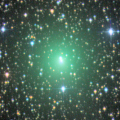
|
Brightening very rapidly. It is already so bright as 8.0 mag (Nov. 21, Con Stoitsis). It will approach to the earth in December and January, and it is expected to brighten up to 5-6 mag. In the Southern Hemisphere, it keeps observable in excellent condition until late January. In the Northern Hemisphere, it keeps extremely low until mid December. But after that, it will be observable in excellent condition.
Date(TT) R.A. (2000) Decl. Delta r Elong. m1 Best Time(A, h)
Nov. 22 7 53.61 -44 37.1 1.238 1.645 94 9.2 3:51 ( 0, 10)
Nov. 29 7 41.83 -44 22.0 1.089 1.585 99 8.7 3:12 ( 0, 11)
|
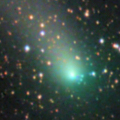
|
The brightness evolution has slowed down before the perihelion passage, and it faded down to 11.6 mag in late October (Oct. 26, Todd Augustyniak). However, an outburst occured around Nov. 10-12, and it brightened by 2 mag. Now it is bright as 9.8 mag (Nov. 17, Chris Wyatt). It is already unobservable in the Southern Hemisphere. It will be unobservable soon also in the Northern Hemisphere. In the Northern Hemisphere, it will be observable in excellent condition after January while the comet will be fading.
Date(TT) R.A. (2000) Decl. Delta r Elong. m1 Best Time(A, h)
Nov. 22 17 43.42 -10 59.4 2.238 1.455 29 9.9 18:19 ( 69, 10)
Nov. 29 17 45.87 -8 49.1 2.326 1.486 24 10.1 18:18 ( 75, 6)
|
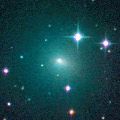
|
It brightened rapidly. Now it is so bright as 10.8 mag (Nov. 18, Carlos Labordena). In the Northern Hemisphere, it keeps observable in good condition until the comet will fade out in next spring. It is not observable in the Southern Hemisphere.
Date(TT) R.A. (2000) Decl. Delta r Elong. m1 Best Time(A, h)
Nov. 22 17 49.58 71 32.5 1.254 1.648 93 10.9 18:19 (157, 40)
Nov. 29 18 18.79 65 2.4 1.335 1.652 89 11.1 18:18 (149, 41)
|
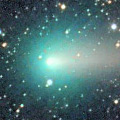
|
The brightness evolution has slowed down just before the perihelion passage. But it brightened up to 6.5 mag in September (Sept. 21, Marco Goiato). Now it is fading. It has faded down to 10.6 mag in October (Oct. 21, Chris Wyatt). It is not observable now. It will be observable again in late December in the Northern Hemisphere, or in mid January in the Southern Hemisphere. But the comet will fade down to 13 mag.
Date(TT) R.A. (2000) Decl. Delta r Elong. m1 Best Time(A, h)
Nov. 22 15 51.07 -10 7.2 2.220 1.259 9 11.2 18:19 ( 86,-12)
Nov. 29 15 53.91 -9 0.6 2.304 1.366 13 11.7 5:18 (277, -6)
|
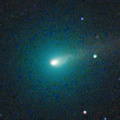
|
Now it is so bright as 10.9 mag (Nov. 21, Chris Wyatt). It keeps observable in the morning low sky at the same brightness for a while. In the Southern Hemisphere, it is too low to observe until December.
Date(TT) R.A. (2000) Decl. Delta r Elong. m1 Best Time(A, h)
Nov. 22 13 0.30 0 15.9 1.831 1.346 45 11.4 5:12 (291, 27)
Nov. 29 13 24.69 -1 46.2 1.826 1.353 46 11.5 5:18 (294, 28)
|
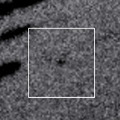
|
Now it is 17.5 mag (Oct. 8, Taras Prystavski). It will brighten very rapidly, up to 10 mag in January. In the Northern Hemisphere, it will be geting higher gradually. In the Southern Hemisphere, it will be getting lower gradually, and it keeps extremely low after January.
Date(TT) R.A. (2000) Decl. Delta r Elong. m1 Best Time(A, h)
Nov. 22 18 50.42 -26 46.3 1.615 1.101 42 13.5 18:19 ( 46, 11)
Nov. 29 19 19.09 -25 37.3 1.573 1.059 41 12.8 18:18 ( 47, 12)
|
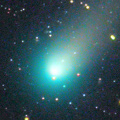
|
It brightened rapidly in outburst in mid October in 2013. Now it is fading. It has already faded down to 13.0 mag (Oct. 18, Con Stoitsis). In the Southern Hemisphere, it keeps observable in good condition for a long time until the comet fades out. In the Northern Hemisphere, it keeps extremely low after this.
Date(TT) R.A. (2000) Decl. Delta r Elong. m1 Best Time(A, h)
Nov. 22 22 3.51 -45 57.1 3.749 3.677 78 13.1 18:19 ( 3, 9)
Nov. 29 22 10.18 -45 5.5 3.899 3.743 73 13.3 18:18 ( 7, 10)
|
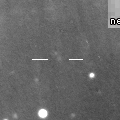
|
It will brighten up to 8-9 mag in 2015 spring. But it is not observable now. In the Southern Hemisphere, it will become observable in January, then it keeps observable in good condition after that. In the Northern Hemisphere, it keeps extremely low and hard to observe from December to 2015 June. It will be observable in good condition after June while the comet will be fading gradually.
Date(TT) R.A. (2000) Decl. Delta r Elong. m1 Best Time(A, h)
Nov. 22 14 36.11 -13 57.0 2.861 1.948 18 13.8 5:12 (287, 0)
Nov. 29 14 52.90 -15 21.5 2.789 1.903 21 13.6 5:18 (291, 2)
|
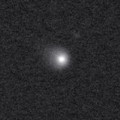
|
Now it is 14.1 mag (Nov. 17, Chris Wyatt). Getting brighter than originally expected, and it is already visible visually. It is expected to brighten up to 4 mag from autumn to winter in 2015. It is observable in good condition in the Southern Hemisphere until the highlight, or in the Northern Hemisphere after the highlight.
Date(TT) R.A. (2000) Decl. Delta r Elong. m1 Best Time(A, h)
Nov. 22 22 25.97 -25 41.6 4.777 4.867 89 13.8 18:21 ( 0, 29)
Nov. 29 22 24.05 -25 38.6 4.831 4.796 82 13.7 18:18 ( 7, 29)
|
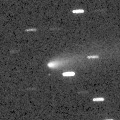
|
Now it is 14.0 mag (Oct. 26, Todd Augustyniak). It is fainter than originally predicted by 2 mag. In the Northern Hemisphere, it keeps observable at 14 mag in excellent condition from 2014 summer to 2015 spring. It locates somewhat low in the Southern Hemisphere.
Date(TT) R.A. (2000) Decl. Delta r Elong. m1 Best Time(A, h)
Nov. 22 10 44.85 18 46.7 1.877 2.027 83 14.0 5:12 (304, 64)
Nov. 29 10 57.10 18 12.0 1.817 2.038 88 14.0 5:18 (313, 67)
|

|
Now it is not observable. It will appear in the morning sky again in January.
Date(TT) R.A. (2000) Decl. Delta r Elong. m1 Best Time(A, h)
Nov. 22 16 27.40 -28 55.0 7.053 6.093 12 14.1 18:19 ( 65,-15)
Nov. 29 16 33.64 -29 4.9 7.065 6.091 8 14.1 18:18 ( 67,-19)
|
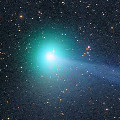
|
It brightened up to 6.0 mag from July to August (July 24, Maik Meyer). Now it is fading. It has already faded down to 13.1 mag (Nov. 15, Uwe Pilz). It will be unobservable soon in the Southern Hemisphere. It will be unobservable in late December also in the Northern Hemisphere.
Date(TT) R.A. (2000) Decl. Delta r Elong. m1 Best Time(A, h)
Nov. 22 19 26.56 -2 5.2 2.917 2.503 56 14.3 18:19 ( 58, 34)
Nov. 29 19 31.13 -2 34.0 3.109 2.595 50 14.7 18:18 ( 62, 30)
|
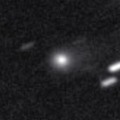
|
Now it is 14.8 mag (Sept. 16, Taras Prystavski). It is expected to brighten up to 13 mag and to be observable in good condition in 2015. It becomes unobservable temporarily from October to January.
Date(TT) R.A. (2000) Decl. Delta r Elong. m1 Best Time(A, h)
Nov. 22 15 58.60 -11 39.1 4.649 3.676 8 14.5 18:19 ( 84,-12)
Nov. 29 16 8.96 -12 6.5 4.624 3.655 9 14.5 5:18 (277,-11)
|
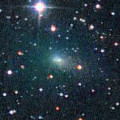
|
Now it is 13.8 mag (Oct. 28, Sandor Szabo). It will be observable at 14.5 mag in excellent condition from October to December.
Date(TT) R.A. (2000) Decl. Delta r Elong. m1 Best Time(A, h)
Nov. 22 5 29.53 31 29.8 0.796 1.741 154 14.5 1:28 ( 0, 86)
Nov. 29 5 25.55 33 19.1 0.793 1.755 160 14.6 0:56 ( 0, 88)
|
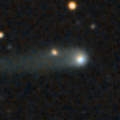
|
Now it is 14.4 mag (Oct. 27, Sandor Szabo). It keeps 15 mag for a long time from 2014 to 2015. It is observable in excellent condition in 2014 in the Southern Hemisphere, or in 2015 in the Northern Hemisphere.
Date(TT) R.A. (2000) Decl. Delta r Elong. m1 Best Time(A, h)
Nov. 22 0 17.09 -26 46.8 3.546 4.001 110 14.8 20:12 ( 0, 28)
Nov. 29 0 13.86 -25 4.8 3.622 3.987 104 14.8 19:41 ( 0, 30)
|
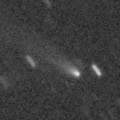
|
Now it is 14.4 mag (Oct. 20, J. Gonzalez). It will be observable at 14 mag in excellent condition in winter.
Date(TT) R.A. (2000) Decl. Delta r Elong. m1 Best Time(A, h)
Nov. 22 22 44.42 -11 7.8 0.951 1.474 98 14.9 18:40 ( 0, 44)
Nov. 29 22 55.29 -8 59.6 0.968 1.443 95 14.8 18:23 ( 0, 46)
|
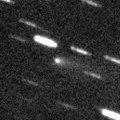
|
Now it is 14.3 mag and visible visually (Oct. 25, Seiichi Yoshida). It keeps observable for a long time after this while the comet will be fading gradually.
Date(TT) R.A. (2000) Decl. Delta r Elong. m1 Best Time(A, h)
Nov. 22 9 50.89 2 43.3 2.121 2.347 90 14.9 5:12 (344, 57)
Nov. 29 9 55.43 1 58.7 2.073 2.389 96 15.0 5:18 (357, 57)
|

|
Now it is 13.5 mag (Oct. 25, Seiichi Yoshida). It keeps bright as 13-14 mag for a long time from 2013 to 2014.
Date(TT) R.A. (2000) Decl. Delta r Elong. m1 Best Time(A, h)
Nov. 22 21 7.73 -25 10.2 3.424 3.269 72 14.9 18:19 ( 19, 27)
Nov. 29 21 15.44 -24 23.7 3.527 3.281 67 15.0 18:18 ( 24, 27)
|
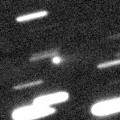
|
Now it is 16.0 mag (Oct. 24, C. Bell). It will brighten up to 15 mag and will be observable in excellent condition from November to February in the Northern Hemisphere. It locates somewhat low in the Southern Hemisphere.
Date(TT) R.A. (2000) Decl. Delta r Elong. m1 Best Time(A, h)
Nov. 22 7 7.66 28 20.2 1.689 2.480 134 15.1 3:05 ( 0, 83)
Nov. 29 7 6.13 27 59.2 1.628 2.478 141 15.0 2:36 ( 0, 83)
|
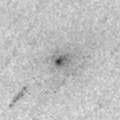
|
Now it is 15.5 mag (Oct. 28, Sandor Szabo). It keeps 15 mag from autumn to winter. It moves southwards fast in winter.
Date(TT) R.A. (2000) Decl. Delta r Elong. m1 Best Time(A, h)
Nov. 22 9 33.54 -1 27.2 1.526 1.862 93 15.1 5:12 (352, 53)
Nov. 29 9 37.74 -5 50.3 1.484 1.883 97 15.1 5:07 ( 0, 49)
|

|
It brightened up to 11-12 mag in 2012. It has already faded down to 14.9 mag (Aug. 12, Taras Prystavski). Appearing in the morning sky again. It will be observable at 15 mag in good condition again in 2015.
Date(TT) R.A. (2000) Decl. Delta r Elong. m1 Best Time(A, h)
Nov. 22 12 9.71 -9 53.1 9.091 8.543 53 15.1 5:12 (309, 29)
Nov. 29 12 9.90 -10 4.3 9.022 8.580 60 15.1 5:18 (317, 34)
|

|
Now it is 13.3 mag (Sept. 22, Seiichi Yoshida). It keeps bright at 13-14 mag for a long time until 2014.
Date(TT) R.A. (2000) Decl. Delta r Elong. m1 Best Time(A, h)
Nov. 22 18 26.83 -13 2.6 7.788 7.041 38 15.2 18:19 ( 61, 16)
Nov. 29 18 29.02 -13 26.9 7.883 7.067 32 15.2 18:18 ( 64, 12)
|
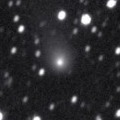
|
Now it is 14.2 mag (Oct. 4, Jakub Cerny). It keeps 13-14 mag and observable in good condition in the Northern Hemisphere for a long time from 2013 to 2014. It locates low in the Southern Hemisphere. Two fragments, B and C, are also visible at 18-20 mag.
Date(TT) R.A. (2000) Decl. Delta r Elong. m1 Best Time(A, h)
Nov. 22 22 35.16 26 15.4 4.148 4.561 108 15.2 18:30 ( 0, 81)
Nov. 29 22 34.84 24 23.7 4.291 4.601 102 15.3 18:18 ( 18, 79)
|
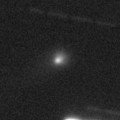
|
Now it is 15.4 mag (Oct. 28, Sandor Szabo). It will brighten up to 14 mag from 2015 to 2016. It is observable in good condition in the Southern Hemisphere. It locates somewhat low in the Northern Hemisphere.
Date(TT) R.A. (2000) Decl. Delta r Elong. m1 Best Time(A, h)
Nov. 22 4 22.43 -25 34.3 4.081 4.817 133 15.4 0:21 ( 0, 29)
Nov. 29 4 11.31 -25 17.9 4.058 4.789 133 15.3 23:37 ( 0, 30)
|
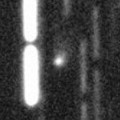
|
Now it is 16.1 mag (Nov. 13, J. Oey, P. Camilleri, H. Williams). The brightness evolution is somewhat slow. It keeps 15-16 mag for a long time from 2014 autumn to 2015 autumn. In the Southern Hemisphere, it keeps observable in excellent condition for a long time. In the Northern Hemisphere, it is unobservable until 2015 June.
Date(TT) R.A. (2000) Decl. Delta r Elong. m1 Best Time(A, h)
Nov. 22 9 8.73 -55 33.8 2.295 2.320 79 15.5 5:06 ( 0, -1)
Nov. 29 8 54.78 -60 50.9 2.216 2.280 80 15.4 4:25 ( 0, -6)
|
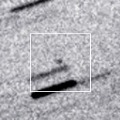
|
It will brighten very rapidly, and will brighten up to 11 mag from January to February. In the Southern Hemisphere, it will be observable in the morning sky after late February while the comet will be fading. It is hardly observable in the Northern Hemisphere.
Date(TT) R.A. (2000) Decl. Delta r Elong. m1 Best Time(A, h)
Nov. 22 14 57.87 -4 3.5 2.381 1.494 20 16.1 5:12 (276, 1)
Nov. 29 15 19.25 -6 14.3 2.329 1.451 20 15.4 5:18 (279, 2)
|
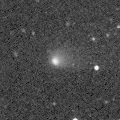
|
It is bright as 14.1 mag still now (Oct. 25, Seiichi Yoshida). It will be fading after this. But it keeps observable until March when it becomes fainter than 18 mag.
Date(TT) R.A. (2000) Decl. Delta r Elong. m1 Best Time(A, h)
Nov. 22 23 39.64 -14 47.1 1.834 2.356 109 15.8 19:35 ( 0, 40)
Nov. 29 23 45.29 -14 2.1 1.924 2.368 104 15.9 19:13 ( 0, 41)
|
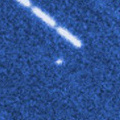
|
Now it is 18.6 mag (Oct. 4, D. Herald). It will brighten up to 9 mag in 2015 spring. But the condition of this apparition is bad. In the Southern Hemisphere, it keeps observable until winter when the comet will be 13 mag. But it is not observable around the brightest days. In the Northern Hemispehre, it keeps extremely low and hard to observe. It will be observable after 2015 autumn when the comet will fade out.
Date(TT) R.A. (2000) Decl. Delta r Elong. m1 Best Time(A, h)
Nov. 22 21 0.03 -45 14.5 2.579 2.382 67 16.0 18:19 ( 15, 8)
Nov. 29 21 11.22 -43 53.6 2.599 2.332 63 15.8 18:18 ( 18, 8)
|
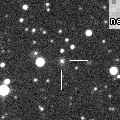
|
Now it is 15.7 mag (Nov. 13, A. Klotz, F. Kugel, J. Nicolas). In the Northern Hemisphere, it keeps 15-16 mag and observable in excellent condition for a long time until early summer in 2015. In the Southern Hemisphere, it is not observable until mid January.
Date(TT) R.A. (2000) Decl. Delta r Elong. m1 Best Time(A, h)
Nov. 22 12 36.94 34 2.6 3.726 3.526 70 15.8 5:12 (256, 49)
Nov. 29 12 46.15 33 35.8 3.663 3.533 74 15.8 5:18 (259, 54)
|
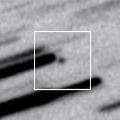
|
Now it is 17.5 mag (Oct. 18, M. Morales). It will pass the perihelion on Mar. 15. In the Northern Hemispehre, it keeps observable in good condition until late February. In the Southern Hemisphere, it keeps observable until mid February, but it locates low.
Date(TT) R.A. (2000) Decl. Delta r Elong. m1 Best Time(A, h)
Nov. 22 4 20.70 39 3.7 0.903 1.861 159 16.1 0:20 (180, 86)
Nov. 29 3 51.72 37 51.3 0.838 1.804 162 15.8 23:16 (180, 87)
|
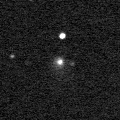
|
Now it is 16.2 mag (Oct. 27, Sandor Szabo). It keeps observable at 15-16 mag for a long time from 2015 to 2016. In the Northern Hemisphere, it is observable in excellent condition. It locates somewhat low in the Southern Hemisphere.
Date(TT) R.A. (2000) Decl. Delta r Elong. m1 Best Time(A, h)
Nov. 22 3 33.72 25 4.4 4.729 5.712 173 15.9 23:28 ( 0, 80)
Nov. 29 3 27.94 25 31.1 4.723 5.691 167 15.9 22:54 ( 0, 81)
|
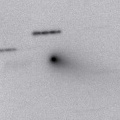
|
It brightened up to 13.8 mag from summer to autumn (Sept. 16, Taras Prystavski). Now it is fading rapidly. It has already faded down to 17.1 mag (Nov. 9, K. Hills). It keeps observable in good condition until February when the comet will be fainter than 18 mag.
Date(TT) R.A. (2000) Decl. Delta r Elong. m1 Best Time(A, h)
Nov. 22 23 56.38 -5 55.1 1.916 2.526 117 15.9 19:52 ( 0, 49)
Nov. 29 0 1.18 -5 20.2 2.022 2.556 111 16.1 19:29 ( 0, 50)
|
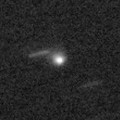
|
It will approach to the sun down to 0.3 a.u. in 2015 July, and it is expected to be bright. Now it is 16.3 mag (Nov. 12, K. Hills). It keeps observable while the comet will be brightening gradually until January when the comet will be 15 mag. The condition is bad after that and it will be hard to observe. But in the Southern Hemisphere, it will be observable after mid July in 2015, and keeps observable while the comet will be fading gradually. In the Northern Hemisphere, it is extremely hard to observe after 2015.
Date(TT) R.A. (2000) Decl. Delta r Elong. m1 Best Time(A, h)
Nov. 22 22 49.52 -27 46.6 3.610 3.798 93 16.1 18:45 ( 0, 27)
Nov. 29 22 47.98 -27 0.8 3.639 3.714 86 16.0 18:18 ( 1, 28)
|
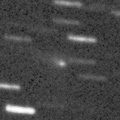
|
First return of a new periodic comet discovered in 2004. It brightened very rapidly as expected. Now it is 16.4 mag (Oct. 28, Catalina Sky Survey). It will be observable in excellent condition from autumn to winter.
Date(TT) R.A. (2000) Decl. Delta r Elong. m1 Best Time(A, h)
Nov. 22 22 52.67 5 40.6 0.750 1.403 106 16.1 18:49 ( 0, 61)
Nov. 29 23 14.62 5 42.2 0.779 1.408 105 16.1 18:43 ( 0, 61)
|

|
It will be higher gradually, and will be observable at 16-17 mag in good condition from winter to spring. It will be observable after January also in the Southern Hemisphere.
Date(TT) R.A. (2000) Decl. Delta r Elong. m1 Best Time(A, h)
Nov. 22 13 33.89 -2 55.2 2.509 1.821 37 16.4 5:12 (288, 19)
Nov. 29 13 51.83 -4 11.6 2.474 1.824 39 16.4 5:18 (291, 21)
|
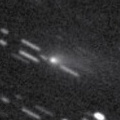
|
It brightened up to 2 mag by unusual major outburst in 2007. It brightened up to 12.6 mag in this apparition (June 25, Taras Prystavski). Now it is fading. It has already faded down to 16.3 mag (Nov. 15, J. F. Hernandez). In the Northern Hemisphere, it keeps observable until it fades out in 2015. In the Southern Hemisphere, it keeps extremely low after this.
Date(TT) R.A. (2000) Decl. Delta r Elong. m1 Best Time(A, h)
Nov. 22 4 47.62 50 51.3 1.827 2.710 147 16.5 0:46 (180, 74)
Nov. 29 4 38.61 50 35.6 1.837 2.739 150 16.6 0:10 (180, 74)
|
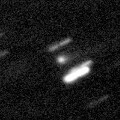
|
Now it is 16.8 mag (Oct. 30, Catalina Sky Survey). It will brighten up to 16 mag in winter, and will be observable in excellent condition.
Date(TT) R.A. (2000) Decl. Delta r Elong. m1 Best Time(A, h)
Nov. 22 8 27.45 13 43.1 3.584 4.080 113 16.5 4:25 ( 0, 69)
Nov. 29 8 28.06 13 26.4 3.493 4.080 120 16.5 3:58 ( 0, 68)
|
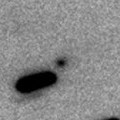
|
Now it is 17.0 mag (Oct. 18, Ken-ichi Kadota). It will brighten up to 16 mag and will be observable in excellent condition in winter.
Date(TT) R.A. (2000) Decl. Delta r Elong. m1 Best Time(A, h)
Nov. 22 10 59.69 8 20.4 2.012 2.024 76 16.6 5:12 (312, 54)
Nov. 29 11 11.95 7 29.7 1.948 2.032 80 16.5 5:18 (320, 56)
|

|
Now it is 16.8 mag (Nov. 15, J. F. Hernandez). It will pass close to the earth from spring to summer in 2016, and it is expected to be observable at 6-7 mag in good condition. In the Northern Hemispehre, it keeps observable in good condition until 2015 spring when the comet will brighten up to 15.5 mag. In the Southern Hemisphere, it keeps low for a long time until 2016 spring.
Date(TT) R.A. (2000) Decl. Delta r Elong. m1 Best Time(A, h)
Nov. 22 6 38.50 35 31.2 5.251 6.038 139 16.9 2:37 (180, 90)
Nov. 29 6 31.68 35 52.6 5.121 5.977 147 16.8 2:02 (180, 89)
|
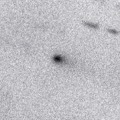
|
It brightened up to 14.6 mag in summer (July 8, Hidetaka Sato). Now it is fading. It has already faded down to 17.2 mag (Oct. 30, Catalina Sky Survey). It is fading much faster than predicted. The condition is good in the Northern Hemispehre. It keeps observable until next February when the comet will be fainter than 18 mag. It locates somewhat low in the Southern Hemisphere.
Date(TT) R.A. (2000) Decl. Delta r Elong. m1 Best Time(A, h)
Nov. 22 8 44.71 13 20.0 1.669 2.203 109 16.9 4:42 ( 0, 68)
Nov. 29 8 45.72 13 11.6 1.631 2.247 116 17.0 4:16 ( 0, 68)
|
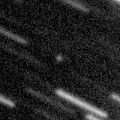
|
Peculiar asteroid with a cometary orbit of 45-years period. Now it is 18.3 mag (Oct. 4, M. Jaeger, et al.). It will brighten up to 17 mag from November to December, and will be observable in excellent condition.
Date(TT) R.A. (2000) Decl. Delta r Elong. m1 Best Time(A, h)
Nov. 22 4 46.87 17 11.0 1.783 2.751 165 17.1 0:46 ( 0, 72)
Nov. 29 4 24.01 13 58.5 1.783 2.764 172 16.9 23:49 ( 0, 69)
|
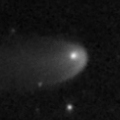
|
Now it is 17.8 mag (Oct. 21, C. Bell). It brightened up to 13 mag from 2011 to 2012. It will be fading after this, but it keeps brighter than 18 mag until 2015 spring.
Date(TT) R.A. (2000) Decl. Delta r Elong. m1 Best Time(A, h)
Nov. 22 3 28.02 -4 35.2 8.242 9.146 154 17.1 23:22 ( 0, 50)
Nov. 29 3 24.73 -4 24.5 8.306 9.182 151 17.1 22:51 ( 0, 51)
|

|
Now it is 17.2 mag (Oct. 28, E. Bryssinck). It will brighten up to 13 mag in 2016. In the Northern Hemisphere, it will be observable at 16 mag in excellent condition in this winter. It locates somewhat low in the Southern Hemisphere.
Date(TT) R.A. (2000) Decl. Delta r Elong. m1 Best Time(A, h)
Nov. 22 6 39.13 27 32.6 2.533 3.355 140 17.3 2:37 ( 0, 83)
Nov. 29 6 35.60 27 44.8 2.450 3.330 148 17.2 2:06 ( 0, 83)
|

|
It brightened up to 12-13 mag from 2012 to 2013. Now it is fading. But it is bright as 16.7 mag still now (Nov. 8, K. Hills). It keeps 16-17 mag until autumn, and will be observable in good condition.
Date(TT) R.A. (2000) Decl. Delta r Elong. m1 Best Time(A, h)
Nov. 22 0 14.11 -17 20.3 3.646 4.167 115 17.3 20:09 ( 0, 38)
Nov. 29 0 13.80 -16 46.5 3.758 4.183 108 17.4 19:41 ( 0, 38)
|
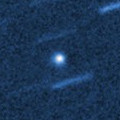
|
Now it is 16.9 mag (Nov. 18, R. Ligustri). It keeps 13 mag for a long time from 2015 to 2016, and will be observable in excellent condition in the Northern Hemisphere. In the Southern Hemisphere, it is observable only until mid 2015 March.
Date(TT) R.A. (2000) Decl. Delta r Elong. m1 Best Time(A, h)
Nov. 22 4 43.33 16 31.7 4.313 5.279 166 17.4 0:42 ( 0, 72)
Nov. 29 4 36.77 16 58.8 4.247 5.229 173 17.3 0:08 ( 0, 72)
|
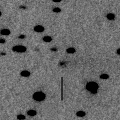
|
Now it is 18.6 mag (Oct. 24, Ken-ichi Kadota). It keeps observable at 17-18 mag from summer to winter in excellent condition in the Northern Hemisphere. It locates somewhat low in the Southern Hemisphere.
Date(TT) R.A. (2000) Decl. Delta r Elong. m1 Best Time(A, h)
Nov. 22 7 11.67 18 49.9 1.752 2.525 132 17.3 3:09 ( 0, 74)
Nov. 29 7 9.08 19 11.6 1.717 2.553 140 17.4 2:39 ( 0, 74)
|
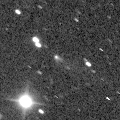
|
Now it is 18.1 mag (Oct. 1, Catalina Sky Survey). It was observed at 17 mag from 2013 to early 2014. It will be observable at 17.5 mag in good condition again from autumn to winter in 2014.
Date(TT) R.A. (2000) Decl. Delta r Elong. m1 Best Time(A, h)
Nov. 22 8 40.72 13 36.8 2.785 3.263 110 17.4 4:38 ( 0, 69)
Nov. 29 8 41.79 13 17.6 2.707 3.276 117 17.4 4:12 ( 0, 68)
|
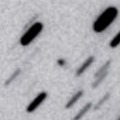
|
Now it is 17.6 mag (Oct. 24, Ken-ichi Kadota). It was observed around 17-18 mag in early 2014. It will be observable around 17-18 mag again from 2014 autumn to 2015 spring, in excellent condition in the Northern Hemisphere. It is not observable in the Southern Hemisphere.
Date(TT) R.A. (2000) Decl. Delta r Elong. m1 Best Time(A, h)
Nov. 22 10 46.58 54 6.1 4.889 5.121 98 17.5 5:12 (213, 65)
Nov. 29 10 50.76 54 20.7 4.815 5.123 102 17.5 5:18 (205, 68)
|

|
First return of a peculiar asteroid 1998 HO121. It keeps observable at 17-18 mag from 2015 to 2016.
Date(TT) R.A. (2000) Decl. Delta r Elong. m1 Best Time(A, h)
Nov. 22 7 26.55 7 3.8 2.738 3.410 125 17.9 3:24 ( 0, 62)
Nov. 29 7 26.27 6 41.5 2.643 3.387 132 17.8 2:56 ( 0, 62)
|
|
![]()
 17P/Holmes
17P/Holmes 269P/2012 R2 ( Jedicke )
269P/2012 R2 ( Jedicke ) 70P/Kojima
70P/Kojima C/2013 X1 ( PanSTARRS )
C/2013 X1 ( PanSTARRS ) 16P/Brooks 2
16P/Brooks 2 2013 NS11
2013 NS11 C/2009 F4 ( McNaught )
C/2009 F4 ( McNaught ) 116P/Wild 4
116P/Wild 4 246P/2010 V2 ( NEAT )
246P/2010 V2 ( NEAT ) C/2014 W2 ( PanSTARRS )
C/2014 W2 ( PanSTARRS ) 191P/McNaught
191P/McNaught 119P/Parker-Hartley
119P/Parker-Hartley C/2013 U2 ( Holvorcem )
C/2013 U2 ( Holvorcem ) (347449) 2012 TW236
(347449) 2012 TW236![]()














































